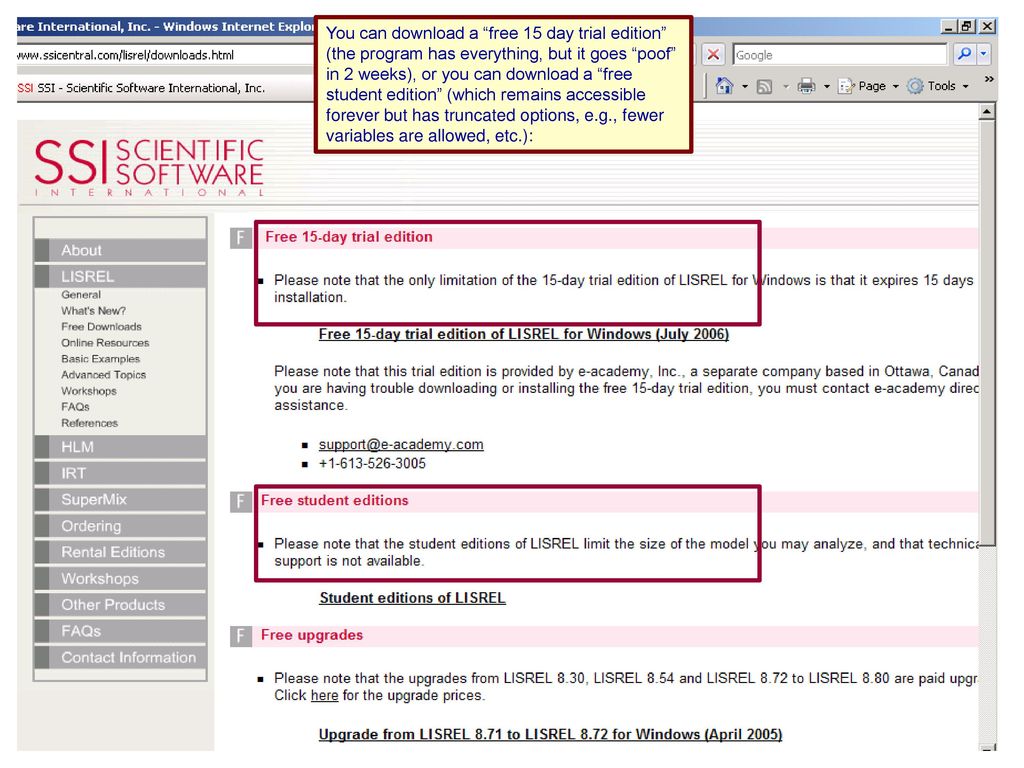Lisrel Free Download

LISREL is the most widespread and common statistical program for the analysis of structural equation models (SEM). In addition, the Lisrel software offers a variety of statistical tools for your voluminous survey data. Although primarily used for the creation of structural equation modeling, the functionality of LISREL provides much more than the analysis of latent structures. LISREL allows e.g.
 The modeling of linear and non-linear hierarchical models and the evaluation of a model in different study groups (group comparison). Thus, investigation into the influence of moderating variables is possible. Have you ever seen a program for structural equation models with such a functionality? LISREL includes not only structural equation modeling, LISREL sofware provides the following additional functions: • PRELIS for data manipulation and for simple statistical analysis • MULTILEV for hierarchical linear and non-linear modeling • SURVEYGLIM for generalized linear models • MAPGLIM for generalized linear models of multi-level data • LISREL for structural equation models. Lisrel - Structural Equation Models (SEM) An essential feature of these applications is that only the dependent variable or the observed response is assumed to be subject to measurement error or other uncontrolled variation. That is, there is only one random variable in the picture.
The modeling of linear and non-linear hierarchical models and the evaluation of a model in different study groups (group comparison). Thus, investigation into the influence of moderating variables is possible. Have you ever seen a program for structural equation models with such a functionality? LISREL includes not only structural equation modeling, LISREL sofware provides the following additional functions: • PRELIS for data manipulation and for simple statistical analysis • MULTILEV for hierarchical linear and non-linear modeling • SURVEYGLIM for generalized linear models • MAPGLIM for generalized linear models of multi-level data • LISREL for structural equation models. Lisrel - Structural Equation Models (SEM) An essential feature of these applications is that only the dependent variable or the observed response is assumed to be subject to measurement error or other uncontrolled variation. That is, there is only one random variable in the picture.
It presents not only the typical uses of LISREL, such as confirmatory factor. ISBN 978-3-319-33153-9; Digitally watermarked, DRM-free; Included format: PDF. Can be used on all reading devices; Immediate eBook download after purchase.
Annapoorna ashtakam lyrics pdf text. Shanmuga Priya & Hari Priya Veeramani Kannan Sri Annapoorna Stothram 35 /. Nanditha Nanditha Sri Annapoorna Ashtakam 36 /. Latha Malathi DV.
The independent variable or treatment level is assumed to be fixed by the experimenter at known predetermined values. The only exception to this formulation is the empirical prediction problem. For that purpose, the investigator observes certain values of one or more predictor variables and wishes to estimate the mean and variance of the distribution of a criterion variable among respondents with given values of the predictors.
Because the prediction is conditional on these known values, they may be considered fixed quantities in the regression model. An example is predicting the height that a child will attain at maturity from his or her current height and the known heights of the parents. Even though all of the heights are measured subject to error, only the childs height at maturity is considered a random variable. Where ordinary regression methods no longer suffice, and indeed give misleading results, is in purely observational studies in which all variables are subject to measurement error or uncontrolled variation and the purpose of the inquiry is to estimate relationships that account for variation among the variables in question. This is the essential problem of data analysis in those fields where experimentation is impossible or impractical and mere empirical prediction is not the objective of the study.
It is typical of almost all research in fields such as sociology, economics, ecology, and even areas of physical science such as geology and meteorology. In these fields, the essential problem of data analysis is the estimation of structural relationships between quantitative observed variables. When the mathematical model that represents these relationships is linear we speak of a linear structural relationship. The various aspects of formulating, fitting, and testing such relationships we refer to as structural equation modeling. Although structural equation modeling has become a prominent form of data analysis only in the last twenty years (thanks in part to the availability of the LISREL program), the concept was first introduced nearly eighty years ago by the population biologist, Sewell Wright, at the University of Chicago. He showed that linear relationships among observed variables could be represented in the form of so-called path diagrams and associated path coefficients. By tracing causal and associational paths on the diagram according to simple rules, he was able to write down immediately the linear structural relationship between the variables.
Wright applied this technique initially to calculate the correlation expected between observed characteristics of related persons on the supposition of Mendelian inheritance. Later, he applied it to more general types of relationships among persons. Today, however, LISREL for Windows is no longer limited to SEM. The latest LISREL for Windows includes the following statistical applications.